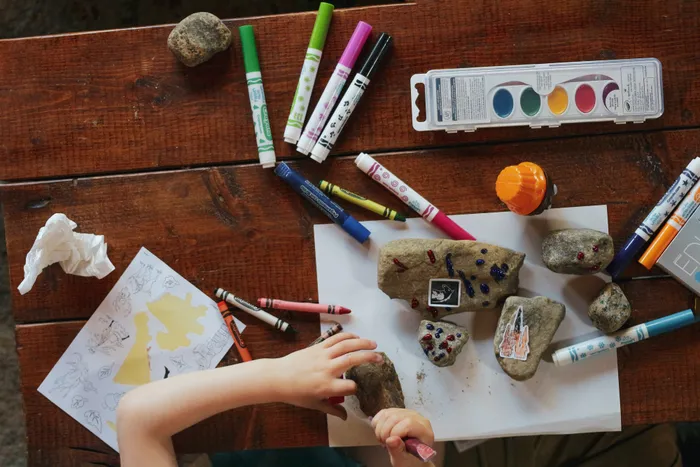The impact of art on critical thinking in children

Art encourages reflection, as children think critically about their artwork and the work of others. Picture: Sigmund /Unsplash
Art has long been appreciated for its ability to encourage creativity and self-expression. However, recent studies have shown that art can also play a significant role in fostering critical thinking skills in children.
Research conducted by Americans for the Arts has revealed that engaging in visual arts activities can enhance problem-solving skills in children. Through art, children are encouraged to think creatively, explore alternative solutions, and make decisions based on their observations and interpretations.
According to a study published in The South African Journal of Education, critical thinking skills are crucial in education and training.
In a world where economic competition is increasing, pupils need to develop the ability to think critically, analyse information and solve problems efficiently.
The study argues that teaching critical thinking is necessary to equip pupils with the skills they need to thrive in a society characterised by an overwhelming amount of information.
The significance of critical thinking skills is further highlighted by the Progress in International Reading Literacy Study (PIRLS) 2021 in South Africa.
The study found that a staggering 81% of grade 4 pupils across all 11 official languages cannot read for meaning. This statistic underscores the urgent need for education systems to prioritise teaching critical thinking skills to help pupils navigate and understand the vast amount of information available to them.
According to Desiree Hugo, academic head: Schools Division at ADvTECH, most good schools, whether public or private, incorporate art into their curriculum, especially in the primary years.
Often this class is seen as a break from the ‘real work’, which is why its importance as a tool for critical thinking is undervalued, she explained.
Interestingly, she added, art incorporates all the important factors required in critical thinking – observation, reflection, interpretation and application. It encourages reflection as children think critically about their artwork and the work of others.

By engaging in artistic activities, children develop observation and perception skills, enabling them to analyse visual information more effectively.
The process of creating art also involves problem-solving and decision-making, as children experiment with different materials, techniques and compositions. Through art, children learn to evaluate possibilities and make informed choices.
Moreover, “art incorporates all the important factors required in critical thinking – observation, reflection, interpretation and application”.
It promotes effective communication and encourages children to analyse their work critically, articulate their artistic intentions, and evaluate the impact of their visual choices on their audience.
Statistical evidence further supports the idea that art fosters critical thinking skills in children. The 2019 National Assessment of Educational Progress found that students involved in arts education demonstrated higher levels of critical thinking skills compared to their peers without arts exposure.
Additionally, the Arts Education Partnership also found that students participating in art programmes were more likely to exhibit critical thinking behaviours, such as analysing problems, developing solutions, and evaluating their work.
Hugo, as an education expert, believes parents and teachers can benefit greatly from educating children in art if they understand its value and how to practise art appreciation.
As parents, we cherish those precious moments when our young children run through the front door, beaming with pride, clutching a piece of artwork in their tiny hands. We praise them for their creative efforts, swiftly affixing their masterpiece to the refrigerator, and continue with our daily routines.
But have we ever stopped to ponder the immense value that lies within these colourful strokes and imaginative compositions?
The advice is to ask specific questions about the artwork, such as “What did you draw there?” or “Why did you make that choice?”
By listening to their explanations and understanding the reasoning behind their creative decisions, parents can get a glimpse of their child’s world and transform the artwork from a mere decorative piece to an opportunity for connection and discussion.
The key is for parents to invest the time and effort to engage in these conversations, said Hugo.
Practical ways schools and parents can use art to develop critical thinking skills:
Open-ended art projects
Provide opportunities and materials for pupils to freely express themselves without tight guidance or direction on expected outcomes or deliverables. This helps them assess the tools at their disposal, use their imagination and problem-solving skills, and hone their craftsmanship.
Artistic analysis
Expose pupils to a wide range of art and lead in-depth discussions about their observations. What do they think the artist was thinking? Why do they think certain choices were made in creating the artwork? How does the art make them feel?
What do they see in the art? This develops their visual processing skills, linking them to their analytical skills.
Combine art and stories
Extend the art lesson by tasking pupils with developing stories based on their work. These stories can include characters and character development, plot lines and inspiration for follow-up art.
Combine art and academics
Maths problems have long been approached by drawing a simple sketch of the problem at hand. This can be extended to various other subjects, by asking pupils to create a visual representation of the matter before them, as well as their proposed solution.
This helps them visualise the problem and helps with brainstorming, all while exercising creative muscles.
“Imagine believing that children can express themselves in more than one way. Now times that by 100, if they are given the tools and encouragement to extend their potential range,” Hugo said.
Related Topics: